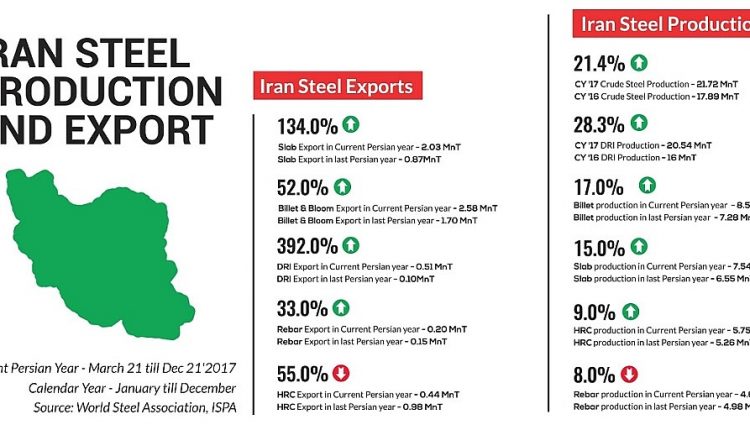Two Major Challenges for Iran’s 2025 Vision
Iran one of the largest steel producer in MENA region has produced 21.70 MnT of Crude Steel in CY’17. Iranian steelmakers aim to increase crude steel output capacity to 55 million tons per till 2025, as per the targets set in the 20-Year Vision Plan (2005-25).
Currently the steelmaking capacity of Iran is around 31 MnT/year and as per Mohammad Shariatmadari, Minister of Industries, Mining and Trade, There are still many miles to go, as the industry has so far attained just over 30 million tons per year in capacity
As per Foolad Technic International Engineering Company, a company that has been studying the Iranian steel market and industry, there are 2 major challenge which Iran might face to accomplish vision 2025 and they are shortage in raw material supply and undeveloped transportation in Iran.
Shortage in Raw Materials:
- According to FIECO, Iran has 5 billion tons of estimated iron ore reserves and 3.1 billion tons of proven reserves. The available amount will be sufficient for producing 55 MnT of crude steel per year. However, the main challenge is sustaining the production figure post-2025.
- According to FIECO’s forecast, Iran will need about 1.1 billion tons of ore by 2025, if steelmakers utilize up to 85% of their capacity. The remaining reserves would be adequate for feeding the industry for only 15 years.
- The government has already identified the shortcoming and with the state-owned holding IMIDRO along with Iran Minerals Production and Supply Company, Government is currently conducting exploration operations in 27 mineral zones across the country.
- Iran must produce 154 MnT of iron ore and 80 MnT of concentrate every year post-2025. For which Iran has to invest in exploration as deep underground exploration is still trouble for Iran due to lack of technology. And secondary US sanctions has made things more difficult.
- US sanctions has made it more difficult for Iran to invite foreign investors for iron ore production chain. And lack of consistent policy making of government has discouraged the local investors to invest in exploration.
Possible Solutions
- The deficit of iron ore concentrate can be fulfilled by importing the raw materials and developing the underdeveloped port infrastructure.
- Iran could come up with new methods for beneficiation of low-content iron ore to make use of its limited reserves. Iran’s average ore content is about 46%..
- The government can help small- and medium-scale miners by providing financial help to establish concentrate plants in nearby to iron ore mines, for lowering costs and boosting economies of scale.
- The government could invest in or purchase iron ore mines in ore-rich countries to sustain the industry supply. If this happened then, the steelmakers located on Iran’s southern coast would highly benefit due to low transportation costs.
Underdeveloped Transportation:
- Current transport system in Iran is inadequate to transport 2025 capacity, Iran’s current total rail transportation capacity is about 40 million tons, and 28 million specifically for steel products.
- The national rail network spanned 13,000 kilometers by the end of the last fiscal year (March 2016-17). The figure needs to reach 25,000 kilometers by the end of 2025.
- Road transportation, on the other hand, is capable of transporting a total of 388 MnT , 66 MT of which are mineral products.
- Iran’s maritime transportation, the most convenient form of transportation for steelmakers located in the southern parts of the country, is capable of moving a total of 145 MnT of goods with mineral products constituting 31 MT.
Possible Solutions
- The rail transportation system, according to FIECO, should be able to carry 105 MnT of downstream and upstream steel products by 2025, including 16 MnT of iron ore, 4 MnT of coal, 32 MnT of iron ore concentrate, 31 MnT of pellet, 5 MnT of direct-reduced iron and 17 MnT of steel products.
- The total capacity of road transportation should reach 457 MnT by 2025, 85 MT of which are meant for steel products.
- Iran Maritime transportation needs to reach 210 MnT by 2025, 50 MT of which are for steel products.
- Development of railroad, road and maritime transportation, according to FIECO, requires €4.8 billion, Euro 1.3 billion and Euro 560 million of investment respectively.
Inputs taken from Financial Tribune

